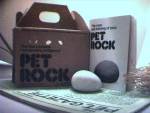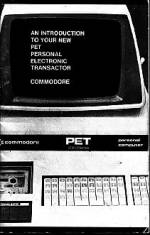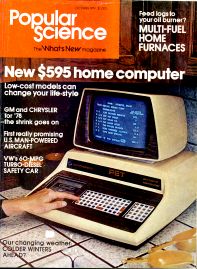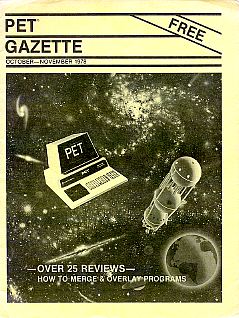Table of Contents
The Commodore PET
The Commodore PET was the first computer introduced by Commodore Business Machines, an office equipment manufactuer, after their acquisition of MOS technologies (who had put out the 6502 processor and KIM-1 single board computer a year previously.)
The First PETs
 The year was 1977, and many folks had put several hundred dollars 'up front' and waited for months in order to receive this machine. It was one of the most 'complete' portable all-in one systems for it's time, including such features as:
The year was 1977, and many folks had put several hundred dollars 'up front' and waited for months in order to receive this machine. It was one of the most 'complete' portable all-in one systems for it's time, including such features as:
- Original Pet Imagebuilt-in 9“ CRT display (monochrome 25 lines of 40 characters)
- 6502 microprocessor
- 4 or 8 k of RAM memory
- built-in BASIC in ROM! (by a small company called MicroSoft!)
- parallel I/O and IEEE-4881) interface ports
- 73 key keyboard w/numeric keypad2)
- built-in cassette storage drive
- upper, lower case AND graphics character sets.
- sturdy metal enclosure3)
 Many now claim the name 'PET Computer' was actually coined after the 'Pet Rock' which was a popular fad a year before, Commodore, to protect from trademark infringement, commonly used 'PET' as an acronym for: Personal Electronic Transactor.
Many now claim the name 'PET Computer' was actually coined after the 'Pet Rock' which was a popular fad a year before, Commodore, to protect from trademark infringement, commonly used 'PET' as an acronym for: Personal Electronic Transactor.
Pet Manual
Pet Manual Cover This is the cover of the first PET manual, Inroducation to your Personal Electronic Transactor.
In the inside cover, there is this statement:
 The potentials of your PET are virtually limitless.
This booklet, by its very nature, is limited.
Many questions will arise that this booklet has not covered or even anticipated.
Write to us at Commodore Business Machines with your questions. We will answer many that you and other users will pose with a newsletter we'll be sending out from time to time to users. Or your answer may be incorporated in a booklet for which we will charge a nominal fee . . . but we will call this to your attention.
User Program
The potentials of your PET are virtually limitless.
This booklet, by its very nature, is limited.
Many questions will arise that this booklet has not covered or even anticipated.
Write to us at Commodore Business Machines with your questions. We will answer many that you and other users will pose with a newsletter we'll be sending out from time to time to users. Or your answer may be incorporated in a booklet for which we will charge a nominal fee . . . but we will call this to your attention.
User Program
Commodore Systems
901 California Ave.
Palo Alto, CA 94304
The manual is 38 pages long (with a few blank pages at the end for notes) and discusses such things as 'unpacking your PET and turning it on', using the keyboard, an overview of BASIC, using the cassette to load a program, pinouts, simple memory map, BASIC command reference, cleaning and troubleshooting your PET (mainly on replacing RAMs, my machine still has a spare RAM, in a plastic rail taped inside the cabinet)
I was fortunate to meet the author of the manual, Rick O'Lehr, who also had developed the diagnostic routines for the computer.
Note: the cover shows that rounded case on the PET, it is actually the prototype PET (the case was carved from wood!) Of course the models released were more angular metal ones, plastic housings did show up in later models but retained the angular appearance customers became accustomed to. The last of the PETs released that did have rounded cases were the European CBM 200 and 8296 models which were more related to the CBM 8000 series than the 40 column PETs.
PET in the Press & Early Publications
Popular Science - Oct 1977
 This was most people's first real good look at the Commodore PET, this is the cover from the October 1977 Popular Science magazine; I remember seeing this picture when I was 12, back then it had the look of science fiction to it - just like what a real home computer should look like.
This was most people's first real good look at the Commodore PET, this is the cover from the October 1977 Popular Science magazine; I remember seeing this picture when I was 12, back then it had the look of science fiction to it - just like what a real home computer should look like.
Again, this is another image of the prototype PET (you get a better view of the rounded corners of the cabinet). The “wood-grain” look on this unit was done with the help of contact paper - close examination of the photo reveals it wasn't the best of jobs. (Though I think it looks kinda cool matching the kitchen cabinets).
Other micros mentioned (and/or pictured) in the article were Heath H-8, Radio Shack (TRS-80, as of then unreleased as well as the PET pictured), Altair 8800, SWTP 6800, IMSAI SBC 8048, Processor Technology's Sol, Technical Design Labs' Z-80 Xitan, Compucolor, Digital Group, Cromemco's Z-2, Polymorphic's Poly 88, Vector Graphic's Vector 1+, OSI's Challenger System, and EPA's 6800 system.
Playboy - Feb 1978
 This image is of page 209 of the February 1978 issue of Playboy magazine, “YOUR OWN PET COMPUTER” portraying the PET as a computer for the 'gentleman sophisticate'. (Photos are of a later machine as this one has the standard folded steel case and the plastic frame around the monitor is black, not pale blue.)
This image is of page 209 of the February 1978 issue of Playboy magazine, “YOUR OWN PET COMPUTER” portraying the PET as a computer for the 'gentleman sophisticate'. (Photos are of a later machine as this one has the standard folded steel case and the plastic frame around the monitor is black, not pale blue.)
The reporter, Richard Izui, described the various screen shots and uses for a PET (those currently possible and those that should come later). The center image is a PET graphic of the playboy bunny (I plan to reproduce it later.) . In the summary of the article ”…As if that isn't enough, your PET can also teach languages and mathematics, store recipes and turn on appliances and temperature controls - all for $595. Our computer says it's a steal.“
PET Gazzette
 Pet Gazzette Oct-Nov 1978 This is the cover of the October/November 1978 PET Gazzette (vol. 1 no. 6), Edited by Len Linsey, which he later help develop into COMPUTE! magazine, it is surprising to see the amount and the sophistication of the products listed only after one year of the computer's release, such things as RS-232 interfaces, memory expansion, chess programs, general ledgers, etc. It was a pretty open territory back then, alot of unrestricted development and business going on. Best of the PET Gazzette, Compute! Magazine Archive
Pet Gazzette Oct-Nov 1978 This is the cover of the October/November 1978 PET Gazzette (vol. 1 no. 6), Edited by Len Linsey, which he later help develop into COMPUTE! magazine, it is surprising to see the amount and the sophistication of the products listed only after one year of the computer's release, such things as RS-232 interfaces, memory expansion, chess programs, general ledgers, etc. It was a pretty open territory back then, alot of unrestricted development and business going on. Best of the PET Gazzette, Compute! Magazine Archive
Some Popular PET Products
The PET as well as the other 'big' micros of the time (such as Apple, and Radio Shack) generated a ton of books, several magazines (many covering all the computers as well as some specific to certain brands.)
Some of my most favorite software on the PET:
- Flash Attack (2 PET computer tank battle game)
- Tunnel Vision/Cat n' Mouse (3-D maze at machine language speed!)
- Artillery (Creative Computing)
- Millipede (On-Line or Nybbles & Bits Software)
- Space Invaders (very true to the arcade)
- Star Force (good Starfire adaptation)
- Time Trek (the klingons are attacking, no time to wait!)
- WordPro 3 (word processor)
- Supermon (ML monitor)
Highlights from Cursor Cassette Magazine
Cursor was a very popular monthly collection of programs on cassette.
Here are some ofmy favorite Cursor programs:
- Rat Run (early 3-D maze program)
- Dungeon (Graphics dungeon type game)
- Ouranos! (Weather War)
- Police!
- Cover #13 (fish tank)
- Cover #8 (space flight)
- Bonzo! (chutes and ladders!)
Cursor Magazine Printed Newsletters included with each issue, recounts some Commodore insider bits that is quite fascinating.
Some Cool Hardware for the PET:
- MTU Visible Memory Board (320×200 hi-res graphics)
There were some really cool drawing programs and games for this including a star trek styled Space War. - Hal Chamberlin Synthesizer Board also sold by MTU. Only heard music from this one once, and man, what nice output!
- Kurta Digitizer Tablet (combined with the MTU board it was a nice early 1980s graphics experimenter)
Some of the best Magazines with PET info:
- COMPUTE! 1978 - around 1984 - Compute! archive
- MICRO: the 6502 Journal - Micro 6502 Journal archive
- Kilobaud Microcomputing 1978-1982 - Kilobaud Microcomuting archive
- Creative Computing 1978-1982 - Creative Computing Archive
- TPUG Newsletter (Toronto PET Users Group) newsletter, the TORPET. - TORPET, TPUG Newsletter
- BYTE (Small Systems Journal) late 70s - early 80s - Byte Magazine archive
- Commodore Microcomputer - Commodore Microcomputer archive
- Transactor Magazine - transactor Magazine archive
